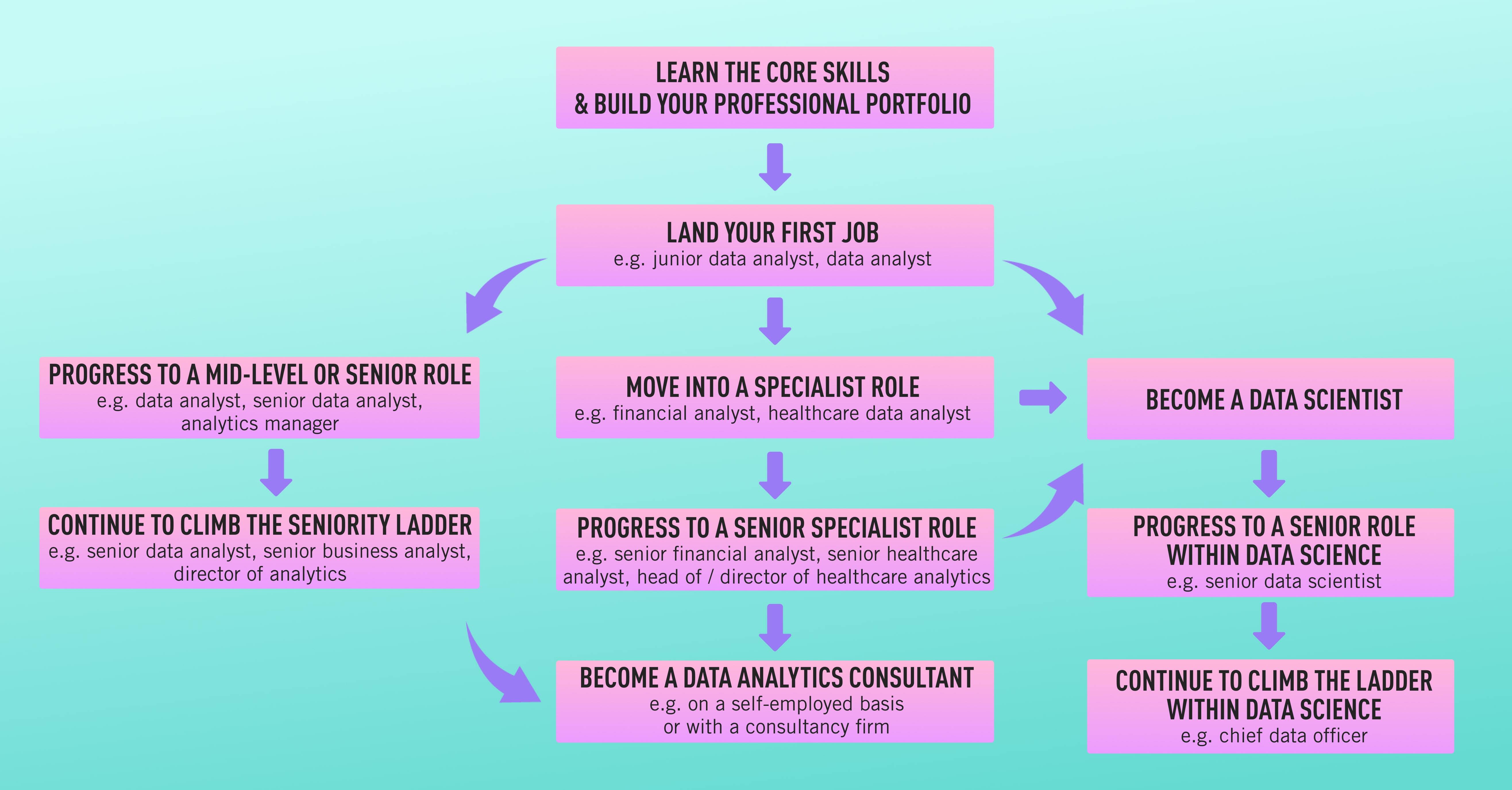When it comes to forging a career in data analytics, it’s important to think about the bigger picture.
What happens once you qualify as a data analyst? What is the typical career path you can expect to follow? Is there one?
In this post, we’ll map out some of the most common data analyst career paths. By the end, you’ll have a clear idea of how to get started as a data analyst, and where your career might take you once you’ve got your foot in the door.
We’ll cover:
- Learning the right skills and qualifying as a data analyst
- Getting your first job
- Progressing to a mid-level or senior role
- Specialist data analyst career paths
- From data analyst to data scientist
- Working as a data analytics consultant
- Data analyst salaries for different levels and job titles
- Key takeaways
So: What’s the typical data analyst career path? Let’s find out.

1. The very beginning of your data analyst career path: Learning the core skills
Your data analyst career path starts with learning the necessary skills. If you’re a complete beginner coming from an unrelated background, you’ll need to get to grips with the entire data analysis process—from preparing and analyzing raw data, to creating visualizations and sharing your insights.
You’ll also need to develop database querying skills with SQL, learn the fundamentals of Python (the go-to language used by analysts), and grasp key concepts such as data mining and ethics. At the same time, you’ll need to be proficient in the essential industry tools such as Excel and Tableau.
Once you’ve acquired the necessary skills, you can think about applying for your first data analyst job. At this stage, it’s important to market yourself as a data analyst—updating your online profiles, writing a resumé geared towards data analytics roles, and building a professional data analyst portfolio.
We’ve made that all sound rather quick and simple, but it’s a process that requires a good amount of time and commitment—especially if you’re starting from scratch. For a structured, guided approach to learning all the necessary skills, consider a dedicated course.
A data analytics certification is a great (and highly respectable) alternative to a university degree, and will tell employers that you’ve gone through rigorous training.
To take the first step in your data analytics career path, check out these free data analytics courses designed for beginners—or, if you feel ready to take on a full course, check out these data analytics certification programs.
Learn more: How to Get Started as an Entry-Level Data Analyst
2. Landing your first job as a “frontline” data analyst
The next step in your career path is to land your first job. As a newly qualified analyst, you can expect to start in a very hands-on role—as a junior analyst or, quite simply, a data analyst. You’ll be responsible for extracting data, cleaning it, performing all the analyses, and sharing your findings. You’ll work closely with business stakeholders and use your insights to guide them in their decisions.
So what determines whether you start out as a junior analyst or go straight in for the data analyst job title? It all depends on your previous experience and the company hiring you.
Generally speaking, you can expect to start off with a junior role if you don’t have any prior experience using analytical skills. If you’ve got some transferable experience from your previous career or studies, you’ll likely be considered for a data analyst position. There’s no hard-and-fast rule on this one, though; it varies greatly across industries and organizations.
The great thing about data analytics is that it relies on a broad range of skills which are often transferable from other professions—such as good communication and an aptitude for problem solving. Even if you’ve never worked as a data analyst, you’ll likely see some of your existing skills and qualities reflected in data analyst job descriptions.
To get a feel for the kinds of jobs you’d be qualified for after completing your data analyst program, browse sites like Indeed and LinkedIn for both junior data analyst and data analyst roles, and see what the general requirements are. Another option is to consider an internship. We show you how to land a data analyst internship here.
Whichever job title you end up with, your first role should give you plenty of hands-on experience with all aspects of the data analysis process.
Learn more: What Does An Entry-Level Data Analyst Do?
3. Climbing the ladder to a mid-level or senior data analyst position
As with many professions, the typical next step in the data analyst career path is to progress to a more senior position. How quickly you climb the ladder will vary depending on the size of the company and whether you’re progressing within your current organization or applying for a new role.
It’s important to remember that there is no one-size-fits-all when it comes to the data analyst career path—we can map out the typical route, but different sectors and organizations will offer different opportunities.
Still, once you’ve gained one or two years’ experience as a data analyst, you can start to think about your next move. Typically, more experienced analysts will work as senior data analysts or analytics managers. Such roles will see you taking ownership of the data processes within your organization, and potentially managing a team of analysts.
Your next steps will also depend on your interests and the industry you choose to work in. Instead of going down the management route, you may choose to specialize as an analyst in a certain field. We’ll take a look at specialist data analyst career paths next.
4. Specialist data analyst career paths
Some data analysts will progress to senior management positions, stepping away from the frontline to focus more on overseeing the company’s overall data strategy and managing other analysts. Others will take the specialist route, honing their expertise in a specific field—such as healthcare, finance, or machine learning.
Data analysts are in demand across a whole host of industries, so you can follow a career path that combines your analytical skills with a particular area of interest. If you do, you could end up with a specialist job title, such as:
- Financial analyst
- Product analyst
- Healthcare analyst
- Machine learning engineer
- Social data analyst
- Insurance underwriting analyst
- Data architect
- Digital marketing analyst
- Systems analyst
- Operations analyst
- Sustainability analyst
Another popular route for data analysts is to eventually move into a data scientist role. We’ll consider how you can make this transition in the next section.
5. From data analyst to data scientist
Although the terms are often used interchangeably, data analytics and data science constitute two distinct career paths.
While data analysts seek to address specific questions and challenges, often looking at static data from the past, data scientists focus on optimizing the overall functioning of the business, using data to predict future outcomes. This is a very pared-down comparison; for a full explanation of the differences between a data analyst and a data scientist, take a look at this guide.
The transition from data analyst to data scientist is not strictly linear, but if you do like the idea of moving into a data science role, your data analysis skills will serve as a good foundation. Typically, data analysts looking to become data scientists will focus on expanding their skillset to include more complex concepts such as data modeling, machine learning, building algorithms, and more advanced knowledge of programming languages such as Python and R.
Just like data analysts, data scientists work across a whole range of industries. If your career path takes you down the science route, you could eventually end up working as a senior data scientist, a machine learning engineer, or even occupying a C-suite role such as chief data officer.
6. Working as a data analytics consultant
After many years in the industry—at least six or seven—many data analysts will go on to become data analytics consultants.
A data analytics consultant essentially carries out the same work as a data analyst, but for a variety of different clients rather than one company. They can work for consulting firms, but many opt for the self-employed route.
So, if you’re wondering whether your data analyst career path could eventually lead you to a more flexible career, the answer is yes!
However, this is something you can realistically consider much further down the line; for the first few years of your career, it’s important to gather as much hands-on experience as possible and to hone your skills in a number of different roles. That way, you’ll be better equipped to work with a variety of clients within different contexts.
Learn more in our full guide to becoming a data consultant.

7. Data analyst career paths and salaries
As you can see, there are many different routes to explore within the field of data analytics. By now, you might be wondering what kind of salary you can expect with each of the different pathways mentioned. To give you an idea, we researched the average salary for a variety of data analytics job titles in the United States.
These figures are based on data from Indeed.com and salary comparison site Payscale:
- Entry-level data analyst: $58,090
- Data analyst: $75,307
- Senior data analyst: $97,348
- Data analytics manager: $89,287
- Financial analyst: $72,281
- Healthcare analyst: $63,411
- Insurance claims analyst: $51,033
- Marketing analyst: $65,848
- Systems analyst: $78,212
- Data scientist: $122,511
- Machine learning engineer: $146,352
- Data analytics consultant: $77,365
- Chief data officer: $178,606
You can learn more about data analyst salaries and how they vary around the world in this guide.
8. Key takeaways
There is no one-size-fits-all approach when it comes to forging your data analytics career path. You can choose to specialize and continue adding more complex skills to your repertoire, or you can become a business and strategy all-star—or a combination of the two!
Once you’ve mastered the fundamentals of data analysis, you can design a career that speaks to both your interests and your talents. Still, every data analyst career path starts in the same place: Learning the key tools, skills, and processes, and building a professional portfolio.
Contemplating a career as a data analyst but not quite sure if it’s right for you? See how you enjoy this free data analytics short course first. You might also find the following guides useful:
